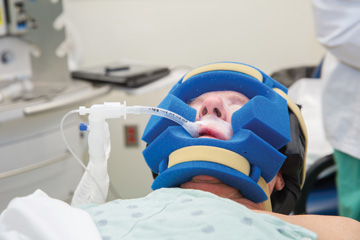Dr. Shifflett says that if a patient mentions anything about a physical issue, even a problem seemingly unrelated to the surgery they’re undergoing, the entire OR team needs to be made aware of it. One of the most effective ways to prevent
a patient from glossing over something that could be of critical importance during the history is to avoid making the process appear rushed and to listen actively and empathetically to all the patient’s responses.
• Regular positioning checks. Providers are often exceedingly careful when they initially position the patient for a spine procedure. Throughout the case, however, the patient may shift or get jostled enough to put them in
a precarious situation. And when surgeons are laser-focused on the surgery at hand, things can get missed. That’s why it’s so important for everyone in the OR to routinely take a step back to check that the patient is still where
they should be — even if it means peeking under the drapes. Dr. Shifflett says it’s common for his staff to double-check on something mid-case. “During the procedure, you’ll often hear our team saying things like, ‘Can
you look under the drapes?’” he says. “Or X-ray techs will call out, ‘Hey, can you check that arm again?’”
Proper positioning can be as simple as putting yourself in the patient’s shoes. “Sometimes I’ll take a step back, look at the patient and ask myself, ‘Does this look comfortable?’ If the answer is no, then I’ll
adjust the patient,” says Dr. Shifflett.
Dr. Vaccaro agrees on the importance of monitoring the patient’s positioning throughout surgery. “A complete visual inspection of the eyes, axilla, elbows, knees and abdomen is a simple but effective way to make sure the patient is
positioned correctly for surgery,” he says.
• Focus on high-risk areas. Vision loss is a risk associated with spine procedures — a complication that Dr. Vaccaro says every surgeon fears. Providers should closely monitor intraoperative eye pressure and watch for
swelling throughout the procedure — especially during longer cases. However, with the threat of vision loss looming as a complication, Dr. Vaccaro urges his team of surgeons to remember one simple but seldom employed tactic that is always
at their disposal: “I always remind them that it’s OK to stop the operation.”
While vision loss is understandably a huge concern, it’s not the only eye-related risk associated with spine surgery. “You also worry about corneal abrasions when the eyelids aren’t covered or are moist,” says Dr. Shifflett.
“You worry about irritation.” The brachial plexus is another area you need to pay extra attention to during spine procedures. “If the patient is on their stomach, make sure the arms aren’t extended more than 90 degrees,”
says Dr. Vaccaro. When men are in this position, the genital region is vulnerable to pressure injuries and ulceration, and catheter movement can lead to urethra injuries, adds Dr. Shifflett.
• Padding and positioning. There are plenty of positioning aids available, but your options are even more expansive than the padding marketed specifically for surgery, and many providers get creative when it comes to padding.
For instance, Dr. Shifflett will purchase an entire egg crate mattress, tear off pieces at a time and use them to pad vulnerable areas. “The pieces are easy to tear off and place around the patient,” says Dr. Shifflett. “The
versatility of the stuff is incredible.” Whatever you use for positioning, don’t forget to add a bite block to the mix, says Dr. Shifflett. “You need to use a bite block when the patient’s jaw is clenched,” he
says. “I heard a horror story from a fellow about a patient who bit off part of their tongue because a bite block wasn’t in place.”
.svg?sfvrsn=be606e78_3)

.svg?sfvrsn=56b2f850_5)